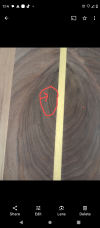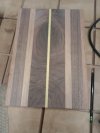I got a cutting board that I'm making and got it sanding to 220. Wiped out off with mineral spirits to get ready to apply finish and noticed a hairline crack-gap-void (not sure technical word for it but a problem I think). It is running along the ring that I have circled in picture. If zoom in you can see it. Seems like on one of our colder nights this week it was more visible (got bigger/worse) and with some what warmer day today wasn't as noticable. I have three questions. The first being would you even worry about it? Second is I was thinking of using black ca glue... Would that stabilize it? And if not how would you go about fixing it? The board is 1" x 8 3/4" x 12 1/2. Wood is walnut that has the void. Thanks in advance
You are using an out of date browser. It may not display this or other websites correctly.
You should upgrade or use an alternative browser.
You should upgrade or use an alternative browser.
Should I or don't worry about it?
- Thread starter Trey1984
- Start date
My experience is that cracks get worse over time, not better. You've already noticed it open up with change in temperature/humidity. If this were veneer being glued to a substrate I wouldn't worry. The book match is beautiful. Is there a way to get glue into the crack? I don't have any experience with the ca glue mentioned, so I can't answer that.
If you haven't put a finish on it the CA should stabilize it. I would fill the crack with very fine walnut sanding dust, apply thin CA in the crack and then sprinkle with dust again. After drying give it a sanding being careful not to make a low spot. Check the opposite side for crack. If you find one repeat the process.
Yeah the ca glue i have is very thin so it will go in pretty easily. And thank youMy experience is that cracks get worse over time, not better. You've already noticed it open up with change in temperature/humidity. If this were veneer being glued to a substrate I wouldn't worry. The book match is beautiful. Is there a way to get glue into the crack? I don't have any experience with the ca glue mentioned, so I can't answer that.
It's just on that one side and luckily I noticed before applying finish. When you mix the sanding dust do you still use the accelerator like normal? ThanksIf you haven't put a finish on it the CA should stabilize it. I would fill the crack with very fine walnut sanding dust, apply thin CA in the crack and then sprinkle with dust again. After drying give it a sanding being careful not to make a low spot. Check the opposite side for crack. If you find one repeat the process.
I've never used any CA that requires an accelerator. Maybe some who has will chime in.It's just on that one side and luckily I noticed before applying finish. When you mix the sanding dust do you still use the accelerator like normal? Thanks
I use the CA glue and saw dust for filling cracks as well and never use accelerator. I suppose you could, but I’ve never felt the need. I start sanding before fully dry with at least 220 around a sanding block and find that helps level it a bit (the paper clogs immediately). The other thing I’ve noticed is when I finish sanding - it’s just a few seconds - there is usually still a dimple so I have to do it a second time (and sometimes third or fourth depending on depth of crack).
One last note is to let it sit and don’t finish it for a few days. The CA glue stops it from splitting where it wants to and there may be more stresses in the board that could result in a crack elsewhere you’ll need to fill. If the finish is on, it’s a frustrating moment. Been there done that.
One last note is to let it sit and don’t finish it for a few days. The CA glue stops it from splitting where it wants to and there may be more stresses in the board that could result in a crack elsewhere you’ll need to fill. If the finish is on, it’s a frustrating moment. Been there done that.
CA glue dose not require an accelerator, it speeds up the setting time of the adhesive from a few minutes to a few seconds. The crack you are dealing with happens based on the orientation of the grain. Looking at your photos that grain orientation is very much an end grain orientation and will move a little more than other orientations. It happens, nothing ventured nothing gained. I hope the repair lasts a long time. By the way pretty boards.
It’s not that it requires it, it’s that an accelerator is handy in many uses. I use accelerator all the time - in fact almost every time. But not in a case like this. I think it’s best to mix the saw dust with the glue, then dribble in the gaps. If it’s a very small gap, just plain glue.I've never used any CA that requires an accelerator. Maybe some who has will chime in.
Trey needs to be aware the crack probably is full thickness or close to it, or will eventually be full thickness. I’m betting when he applies the glue it runs out the other side, so be careful about laying this down on your bench!!.
Future movement or further cracking would be a concern, and IMO CA glue is not going to stop that, it will just crack in another place. When wood wants to move something’s gonna give. But I would think once it is infused with mineral oil that should seal it off further drying?
No doubting it’s a beautiful cutting board, but there is always risk using that type of grain in an unrestrained panel like a cutting board. Breadboard ends would be a consideration. It’s not too late, and you can even wait and see what happens and do it later.
I think Steve has it right…CA with or without accelerator and the matching wood dust. What about a dutchman (bow tie or another shape)…that would prevent the crack from widening but may not be the aesthetic you are looking for.
It is a really small crack. Maybe a 64th. I want to try bowties but not really what wanting to go with on this one.I think Steve has it right…CA with or without accelerator and the matching wood dust. What about a dutchman (bow tie or another shape)…that would prevent the crack from widening but may not be the aesthetic you are looking for.
In my opinion I would not use accelerator, if it is a viewable surface you run the risk of blushing(white haze in surface finish). Apply C/a in crack let sit for a few mins to soak in. Sprinkle in walnut dust, wet out dust with c/a, sprinkle more dust. Do this slowly to build slightly proud of the finished surface. Let's cure for a full 24 hours- check for more cracks. You would also benefit from talking the board into a temp controlled environment and rest for a few days before finishing.
That separation appears to follow the annular ring. CA glue soaking is about the only option for stabilizing things. I think that crack is what I know of as wind shake where the annular ring shears because the tree was subjected to intense bending stress during that year of growth. Its rare but not unheard of An extreme example below when I was cutting up some wood for turning stock. I tossed the slug on the floor and it split. The whole log had that bad annular ring and had to be discarded. I sure didn't want that condition in a piece of wood I'd be turning. The whole lot went to the burn pile.



LATEST FOR SALE LISTINGS
-
-
-
-
-
SOLD -- $75: Gast moa v113 Vacuum Pump Veneer, 60" bag and board
- Started by peterdnight
- Replies: 1


